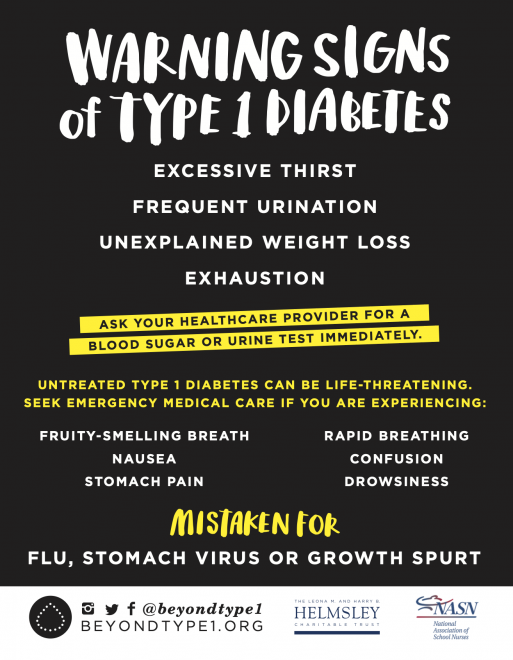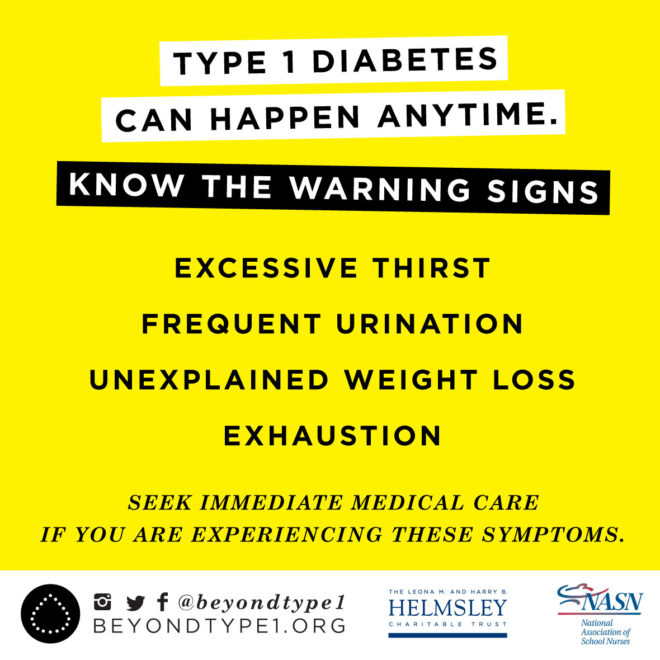Type 1 diabetes symptoms can develop in just a few weeks or months and can be severe. Without the energy that sugar supplies muscle tissues and fat stores simply shrink.
/hyperglycemia-symptoms-5ada088fba617700366b24fc-707a0c35777444ac9457d5b09719ddb8.png)
Type 2 Diabetes Signs Symptoms And Complications
/type-1-diabetes-understanding-the-complications-3289597-3c871352abd34df1b6325bcc12ce0d56.png)
Understanding The Complications Of Type 1 Diabetes

Few Significant Difference Between The Type 1 And 2 Diabetes
Type 1 diabetes is different than type 2 diabetes for a slew of reasons.

Type 1 diabetes symptoms. Central to the treatment of type 1 diabetes is to keep a balance of the right amount of insulin to keep blood glucose levels from being either too high or too low. Type 1 and type 2 diabetes share common symptoms. Environmental factors and exposure to some viral infections have also been linked to the risk of developing type 1 diabetes.
10 to 15 mmolL is a range in which it is a good idea to call your diabetes care team 15 to 30 mmolL is a sign of DKA risk and indicates that you should call your diabetes care team More than 30 mmolL is considered a medical emergency and indicates that you should go to the emergency room or call 911. Symptoms of type 1 diabetes onset in an infant or child. Here doctors explain type 1 vs.
Symptoms of Type 2 Diabetes. Diabetes Mellitus is the Latin name for diabetes Type 1 diabetes mellitus occurs when the cannot produce insulin which is needed to control blood glucose levels. Causes signs and treatment options.
Learn more about the symptoms causes diagnosis and. Type 1 diabetes happens when your immune system destroys cells in your pancreas that make insulin. Cuts and wounds take longer to heal.
Genital itching or thrush. Feeling more tired than usual. Without insulin our bodies cannot use the sugar in our bloodstream as energy causing people to experience Diabetic ketoacidosis DKA.
Find out why thirst headaches and infections could be signs of diabetes. Type 2 diabetes is a long-term medical condition in which your body doesnt use insulin properly resulting in unusual blood sugar levels. The risk factors for type 1 diabetes are still being researched.
Insulin is a hormone needed to allow sugar glucose to enter cells to produce energy. If left untreated or improperly managed type 1 diabetes can lead to health complications. Type 1 diabetes is a serious autoimmune disease in which a persons pancreas stops producing insulin a hormone essential to getting energy from food.
It is divided into 3 main sections. Having a parent or sibling with the disease may increase your chance of developing type 1 diabetes. Type 1 diabetes is a disorder characterized by abnormally high blood sugar levels.
Learn about type 1 diabetes and how to manage daily diabetes care. In type 1 diabetes the bodys immune system kills of the insulin producing cells leaving the pancreas unable to produce enough insulin to. However having a family member with type 1 diabetes slightly increases the risk of developing the disease.
Type 15 diabetes also called latent autoimmune diabetes in adults LADA is a condition that shares characteristics of both type 1 and type 2 diabetes. Learn more about the symptoms causes diagnosis treatment and complications of type 1 diabetes. Type 2 diabetes mellitus which is much more common occurs when the body can not produce enough insulin or the insulin is not working effeciently enough.
Type 1 diabetes which was formerly known as juvenile diabetes is a chronic autoimmune condition that makes the body unable to produce insulin which is the hormone that regulates blood sugar. Gestational diabetes mellitus occurs when pregnant women have high. No matter how type 1 diabetes has shown up in your life you can find success by balancing your medications and sticking to your daily exercise routine and nutrition plan.
This includes individuals with newly diagnosed or longstanding type 1 diabetes and many people with insulin-treated type 2 diabetes. Going to the toilet a lot especially at night. Insulin is a hormone that.
The most common. The young child who is urinating frequently drinking large quantities losing weight and becoming more and more tired and ill is the classic picture of a child with new-onset type 1 diabetes. Before type 2 diabetes develops certain areas of the skin begin to darken.
These areas are often found around the neck or in the armpits. Skip directly to site content Skip directly to page options Skip directly to A-Z link Centers for Disease Control and Prevention. Recognize the signs and symptoms of type 1 diabetes before diagnosis.
Symptoms of type 1 diabetes. Type 1 diabetes typically occurs in children and young adults although it can appear at any age. In the United States about 5 percent of people with diabetes have type 1.
Type 1 diabetes is treated with insulin injected into the body and a healthy lifestyle. Discover the treatment options for people with type 2 diabetes including medicines and lifestyle improvements. Symptoms of Diabetes Type 1 in Adults If youre wondering about the signs and symptoms of type 1 diabetes in adults youre not alone.
LADA is diagnosed during adulthood and. Learn about type 2 diabetes warning signs symptoms diagnosis and treatment options. Whether youve been newly diagnosed with type 1 diabetes are helping a loved one or have been managing your condition for a while help is here.
While your lifestyle choices didnt cause type 1 diabetes the choices you make now can reduce the impact of diabetes-related complications including kidney disease limb amputation and blindness. Symptoms of type 1 and type 2. Type 2 diabetes symptoms often take several years to develop.
Type 1 diabetes is managed with insulin injections several times a day or the use of an insulin pump. Using this Website This website can help you learn about and live a healthy life with type 1 diabetes. Diabetes means your blood glucose or blood sugar levels are too highWith type 1 diabetes your pancreas does not make insulin.
Type 1 diabetes once known as juvenile diabetes or insulin-dependent diabetes is a chronic condition in which the pancreas produces little or no insulin. In this form of diabetes specialized cells in the pancreas called beta cells stop producing insulinInsulin controls how much glucose a type of sugar is passed from the blood into cells for conversion to energy. However weight loss is less common in children with type 2 diabetes than in children with type 1 diabetes.
Featured Workshop 3½ Day Insulin Workshop. Type 1 diabetes usually starts when youre a child teen or young adult but can happen at any age. The 3½-day class is recommended for people who require insulin to control diabetes.
Losing weight without trying to.

Type 1 Diabetes

Warning Signs Of Type 1 Diabetes

Type 1 Diabetes Symptoms Causes Diagnosis And Treatments Causes Symptoms Diagnosis Treatments And Support

Warning Signs Of Type 1 Diabetes

Type 1 Diabetes Mellitus Causes Symptoms And Treatment

What Is Type 1 Diabetes In Children Dr Kashif Ali Ansari
Type 1 Diabetes Symptoms Stock Illustration Download Image Now Istock
Type 1 Diabetes Boston Children S Hospital



